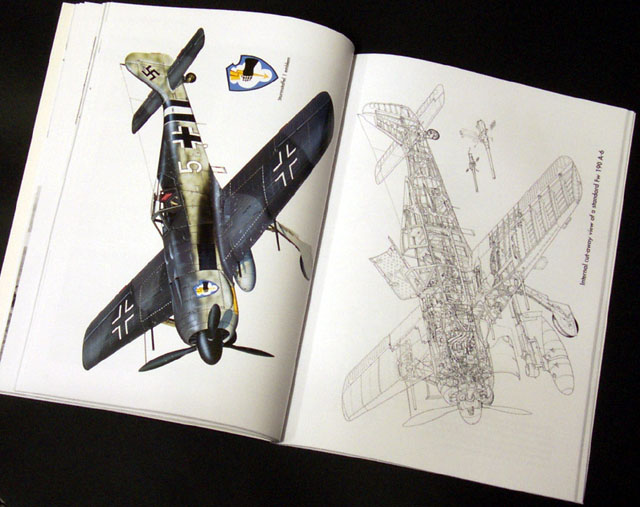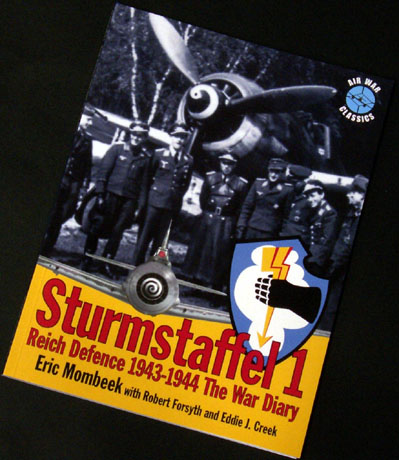|
Sturmstaffel 1
Reich Defence
1943-1944
The War Diary
By Eric Mombeek
with Robert Forsyth & Eddie J. Creek

Classic Publications
S u m m a r y
|
| ISBN: |
0-9526867-9-1 |
| Media: |
Soft cardboard cover; 300mm x
220mm in portrait format; 96 pages; 166 photographs; 10 colour
profiles; tables; technical drawings. |
| Price: |
£14.95 plus shipping,
online from Classic
Publications |
| Review Type: |
First Read |
| Advantages: |
Fascinating story of the
Luftwaffe's famous "ramming" unit; logical structure and readable
text; excellent wartime photos of aircraft and personnel; pilot's
first-hand accounts; supplementary information supplied in tables
and sidebars. |
| Disadvantages: |
|
| Recommendation: |
Recommended for any Luftwaffe
history buffs or modellers |
Reviewed by Brett Green

HyperScale is proudly supported by Squadron.com
Sturmstaffel 1 was born out of desperation and existed for only six
months. Despite the short timeframe, its reputation has endured thanks
to its last-resort tactic of ramming Allied bombers.
Eric Mombeek's book, "Sturmstaffel 1 - Reich Defence 1943-1944 The
War Diary", explores the background, the operations and epilogue of
this famous unit.
 The
book successfully explains the reasons behind, and the practical
application of, the apparently fanatical ramming tactic. The
book successfully explains the reasons behind, and the practical
application of, the apparently fanatical ramming tactic.
The opening chapter describes the impact of the American daylight
bombing campaign during 1942 and 1943. It also explains the peril faced
by German fighter pilots in dealing with the dreaded American "Vierbombers".
Even without fighter escorts, a B-17F could aim 12 .50 calibre Browning
machine guns at an attacking aircraft. Variations in attack methods had
some impact on the percentage chances of success, but the most frequent
form of attack - from the rear - was an almost suicidal prospect owing
to the deadly cones of defence thrown out from the bomber. A German
fighter was in less danger from the hail of lead by attacking from the
front, but success required remarkable marksmanship and steady nerve.
The risk of collision was also a grave possibility.
Goering's rage at the uninterrupted Allied bombing attacks led to one
of his loyal officers devising a method of defence that would provide a
better chance of both success and survival. By attacking in a group from
the rear at close quarters, a formation of fighters would dilute the
defensive capabilities of a "vierbomber" by spreading fire across
several aircraft. Furthermore, greater firepower would be brought to
bear on the vulnerable wings and engines of the B-17 by the group of
attacking fighters. There seems little argument about the logic of this
tactic proposed by Hauptman von Kornatzi. However, he also proposed that
fighters should ram the bombers when they ran out of ammunition. This
was not rhetoric - the pilots of the new unit were volunteers who
understood the requirement and had to sign a pledge to fulfil it.
The bulk of the book describes the aircraft, the personnel, the
weapons and the operations of Sturmstaffel 1 using a blend of text,
photos, profiles and tables.
The text is chronologically structured and highly readable. The
narrative text maintains objectivity throughout the book, and relies on
the first-hand accounts of aircrew to offer opinions on the
effectiveness of the tactics of Sturmstaffel 1.
More than 160 photographs will provide ample inspiration for
modellers. Personnel and aircraft are thoroughly covered, including many
close-up shots of markings and aircraft details. The bulk of aircraft
photos are, not surprisingly, Focke-Wulf Fw 190As. These photos are
supported by technical drawings.
Ten colour profiles of Focke-Wulf Fw 190As by Tom Tullis and Dennis
Davison are also included. These are another highlight, and are well up
to the high standards of these artists.
This book does not claim to be a definitive historical account of
Sturmstaffel 1. However, it succeeds in its aim of creating an
impression of the unit and its personnel from the fragments of
information that remain today.
The use of photographs, line drawings, profiles and tables enhance
the story.
I found that "Sturmstaffel 1 - Reich Defence 1943-1944 The War
Diary" gave me real insight into the background and operations of
this short-lived unit. It will be of interest to Luftwaffe historical
buffs and modellers alike.
Recommended.
Eric Mombeek's "Sturmstaffel
1", and other Classic books, may be purchased through
specialist bookstores worldwide or from
Classic Publications Website
Review Copyright © 2001 by
Brett Green
This Page Created on 10 December, 2001
Last updated
22 July, 2003
Back to
HyperScale Main Page
Back to
Reviews Page |
Home | What's
New | Features
| Gallery |
Reviews | Reference
| Forum
| Search